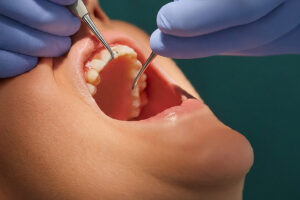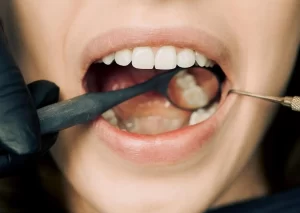How to remove tartar from teeth without dentist

Tartar buildup on teeth is not just a cosmetic concern; it can lead to serious dental issues if left unchecked. While regular visits to the dentist are the best option for deep cleaning and oral health assessments, there are ways to manage and remove tartar from the comfort of your home.
In this article, we’ll explore practical and natural methods to tackle tartar buildup without professional intervention.
From simple daily habits to effective DIY remedies, you’ll learn how to maintain a bright, healthy smile and prevent the risks associated with tartar.
Whether you’re looking to enhance your oral hygiene routine or find interim solutions between dental visits, these insights will empower you to take control of your dental health.
Table of Contents
What is Tartar?
Tartar, also known as dental calculus, is a hard, crusty deposit that forms on teeth when plaque hardens. It can vary in color from yellow to brown and accumulates both above and below the gum line.
Tartar buildup can lead to gum disease, tooth decay, and bad breath if not removed. Unlike plaque, which is a soft film of bacteria, tartar is tough and requires professional dental tools or specific at-home techniques for removal.
What Does Tartar Look Like?
Tartar can appear as a rough, porous texture on the teeth, often noticeable at the base of the teeth or along the gumline. Its color may range from yellow to brown or even black in some cases, depending on the level of staining from foods, beverages, or smoking.
Tartar buildup can make teeth look discolored and feel uneven or bumpy to the touch. In advanced stages, it might lead to swelling or redness of the gums, indicating potential gum disease.
Can You Remove Tartar at Home?
Removing tartar at home can be challenging, as tartar is a hard, calcified deposit that typically requires professional dental tools for complete removal.
There are ways to reduce its buildup and slightly manage its presence through meticulous oral hygiene practices and natural remedies.
Some home remedies, such as baking soda mixtures or vinegar rinses, may also assist in loosening tartar, making it easier to brush away. Still, these methods cannot replace professional dental cleaning for removing tartar effectively, especially once it has firmly adhered to the teeth or below the gum line.
How to remove tartar without a dentist?
Removing tartar from your teeth without a dentist involves a combination of good oral hygiene practices and natural remedies.
Here’s how to manage tartar buildup at home:
Brush Your Teeth Twice a Day
Brushing your teeth twice daily for two minutes with fluoride toothpaste is the first step in preventing tartar buildup. Use a soft-bristled toothbrush and gentle, circular motions to clean all surfaces of your teeth.
Use Tartar Control Toothpaste
Some toothpastes are specially formulated to fight tartar buildup. Look for products containing pyrophosphates, triclosan, or zinc citrate, which have been shown to reduce the formation of new tartar.
Floss Regularly
Flossing daily helps remove plaque from areas your toothbrush can’t reach, particularly between the teeth and under the gumline, preventing it from hardening into tartar.
Use Natural or Homemade Remedies
- White Vinegar: Its acetic acid helps prevent demineralization of enamel and reduces tartar. Rinse with a mixture of white vinegar and water.
- Glycerine and Aloe Vera: Mix a teaspoon of glycerine with aloe vera gel, lemon juice, and baking soda for a natural toothpaste that fights tartar.
- Baking Soda: Brushing with a mixture of baking soda and salt can help remove surface stains and reduce tartar.
- Orange Peels: Rubbing fresh orange peels directly on your teeth before bed can help reduce tartar without harsh chemicals.
- Guava Fruit and Leaves: Chewing guava leaves or unripe guava helps soothe gum inflammation and reduce plaque.
- Sesame Seeds: Chewing sesame seeds and then brushing without toothpaste can act as a natural scrub, removing plaque and tartar.
- Eating Spicy Foods: Spicy foods stimulate saliva production, which helps clean teeth and gums naturally.
- Use Vitamin C Rich Foods: Foods high in vitamin C can create an inhospitable environment for bacteria and prevent tartar buildup.
Prevent It Before It Starts
The most effective strategy is prevention. Maintain a diet low in sugar and starches, avoid smoking, and drink plenty of water throughout the day to wash away food particles and bacteria.
Regular dental check-ups, even if you’re not experiencing problems, are crucial for catching issues before they escalate.
How does a dentist remove tartar?
When removing tartar, dentists employ a two-step process involving specialized tools to ensure thorough cleaning without harming the teeth or gums.
Ultrasonic Scaler
The initial step often involves an ultrasonic scaler, a device that uses vibrations to break up large pieces of tartar. It emits a high-frequency sound wave which, when combined with a stream of water, helps to loosen and flush away tartar deposits from the teeth and gum line.
The ultrasonic scaler’s tip vibrates rapidly to effectively break down the tartar, making it easier to remove while also washing away debris and bacteria.
Hand Scaler
After the bulk of the tartar has been removed with the ultrasonic scaler, dentists switch to hand scalers for finer cleaning. These manual tools come in various shapes and sizes, tailored to clean specific areas of the mouth, such as between teeth or along the gum line.
Dentists use hand scalers to meticulously scrape away any remaining tartar deposits, ensuring that all surfaces of the teeth are clean and smooth. This step allows for precise control and the ability to reach areas that the ultrasonic scaler might not fully clear.
How to prevent tartar buildup in the future
Here is what to do, in order to minimize the chances of dental calculus in the future:
- Get regular dental visits: Beyond tartar removal, regular dental check-ups can help catch and address other oral health issues early on.
- Improve your brushing technique: Use a soft-bristled toothbrush and fluoride toothpaste, brushing at a 45-degree angle to the gums with gentle, circular motions.
- Use antiseptic mouthwash: Helps reduce plaque bacteria and can reach areas not easily accessed by brushing and flossing.
- Get a healthy diet: Limit sugary and starchy foods and drinks that can contribute to plaque and tartar buildup. Instead, eat plenty of fruits, vegetables, and other foods that stimulate saliva production, which helps clean the mouth naturally.
- Stay hydrated: Drinking water helps wash away food particles and bacteria in the mouth, reducing the risk of tartar formation.
- Quit smoking: Smoking increases the risk of tartar buildup, gum disease, and other oral health problems.
How to remove plaque without a dentist
Removing plaque without a dentist involves maintaining a diligent oral hygiene routine at home. Here’s how you can effectively manage and remove plaque:
Brush Regularly
Brush your teeth at least twice a day using fluoride toothpaste. Use a soft-bristled toothbrush and ensure you brush all surfaces of your teeth with gentle, circular motions.
Floss Daily
Flossing once a day helps remove plaque and food particles from between your teeth and under the gumline, areas where your toothbrush can’t reach.
Use Antiseptic Mouthwash
Rinsing with an antiseptic mouthwash can help reduce plaque and remove remaining food particles after brushing and flossing.
Consider Interdental Brushes or Water Flossers
For those with braces, wide gaps between teeth, or difficulty flossing, interdental brushes or water flossers can be effective in removing plaque between teeth.
Diet and Lifestyle Changes
Reduce your intake of sugary and starchy foods and drinks, as they contribute to plaque formation. Drinking plenty of water helps rinse away food particles and bacteria.
Chew Sugar-Free Gum
Chewing sugar-free gum after meals can help increase saliva flow, neutralizing acids and removing food particles from the mouth.
Regular Dental Check-Ups
While this involves a dentist, regular professional cleanings and check-ups are crucial for removing plaque that has hardened into tartar and for preventing dental issues.
FAQ on How to remove tartar from teeth without a dentist
Is there a way to remove tartar yourself?
Attempting to remove tartar yourself is not recommended due to the risk of damaging your teeth and gums. Tartar removal requires professional dental tools and expertise. The best approach is to prevent tartar formation through diligent oral hygiene—brushing twice daily, flossing regularly, using antiseptic mouthwash, and maintaining regular dental check-ups. For safe and effective tartar removal, seek a professional dental cleaning.
Does apple cider vinegar dissolve tartar?
Apple cider vinegar has been touted for its potential health benefits, but there’s no scientific evidence to support that it can dissolve tartar. While acidic solutions can sometimes help in breaking down plaque, tartar is a hardened deposit that requires mechanical removal by a dental professional. The acidity in apple cider vinegar can erode tooth enamel if used improperly. Approach such remedies with caution and prioritize established dental care practices for managing tartar.
What happens when tartar breaks off?
When tartar breaks off, especially if it happens spontaneously or through improper attempts at removal, it might provide temporary relief from the rough feeling on the teeth. However, this does not address the underlying issue of tartar buildup and potential gum disease. Tartar breaking off teeth can also leave rough surfaces on the teeth where bacteria can gather, increasing the risk of further dental problems.
Does peroxide break down tartar?
Hydrogen peroxide can help in managing oral bacteria and whitening teeth, but it does not break down tartar. Tartar requires mechanical removal by a dental professional. While hydrogen peroxide may help in reducing plaque and preventing its hardening into tartar when used as part of a dental care routine, it cannot remove tartar that has already formed.
What is a simple trick to remove tartar?
There’s no simple trick for removing tartar once it has formed. Tartar removal requires professional cleaning by a dentist or dental hygienist. The best approach to manage tartar is prevention: brush your teeth twice a day with fluoride toothpaste, floss daily, use an antiseptic mouthwash and maintain regular dental check-ups for cleaning and examination.
How can I remove hardened tartar from my teeth at home?
Removing hardened tartar at home is not safe or effective. Tartar can only be safely removed by a dental professional using specialized tools. Attempting to remove tartar yourself can lead to damaged tooth enamel, gum injury, and infection. The best approach is to prevent tartar formation through proper oral hygiene: brushing twice daily with fluoride toothpaste, flossing regularly, using an antiseptic mouthwash, and seeing a dentist for regular cleanings.
Can you scrape tartar off your own teeth?
While it’s technically possible to scrape some tartar off your own teeth using dental tools, doing so is not recommended. Attempting to remove tartar at home can lead to gum damage, infection, enamel erosion, or even accidentally injuring your mouth or gums. Professional dental tools and techniques are specifically designed to safely and effectively remove tartar without damaging the teeth or gums. Dentists and dental hygienists are trained to perform these procedures in a way that minimizes the risk of infection and ensures thorough removal.
How long does it take for baking soda to remove tartar?
Baking soda can help remove plaque and minor surface stains from teeth, but it does not effectively remove tartar once it has formed. Tartar is a hard, calcified deposit that typically requires professional dental tools for removal. While baking soda may help in reducing plaque buildup and preventing tartar over time with regular use, it cannot eliminate existing tartar.
What toothpaste dissolves tartar?
No toothpaste can dissolve tartar once it has formed. Tartar, or dental calculus, is too hard and firmly attached to be dissolved by toothpaste. However, there are tartar control toothpastes available that can prevent tartar from forming by reducing plaque buildup. These toothpastes typically contain active ingredients like fluoride, pyrophosphates, zinc citrate, or triclosan, which help prevent plaque from hardening into tartar. For existing tartar, professional dental cleaning is required to remove it safely and effectively.
How Does Tartar Impact Your Oral Health?
Tartar buildup on teeth can significantly impact oral health by leading to gum disease, tooth decay, and bad breath. It provides a rough surface that harbors bacteria, increasing the risk of gingivitis and periodontitis. Over time, tartar can cause receding gums, infection, and even tooth loss. Its hard, porous nature makes it difficult to clean teeth effectively, exacerbating oral health issues and potentially leading to more severe systemic health problems if left untreated.
How long does it take for a dental plaque to convert into tartar?
Dental plaque can begin to harden into tartar within just 24 to 72 hours after it forms on the teeth. Without proper removal through brushing and flossing, plaque starts to mineralize and turn into tartar, or dental calculus, in as little as 48 hours, although the full process can take up to 10 days.
This rapid progression highlights the importance of daily oral hygiene practices to prevent plaque from evolving into the harder, more problematic tartar that requires professional dental cleaning to remove.
Fact Checked
Our dedicated team rigorously evaluates every article and guide to ensure the information is factual, up-to-date, and free of bias.
Updated Regularly
We update our articles and reviews regularly to ensure you have access to the latest data in the dental industry.
The content on Dental3DU’s blog is intended for educational purposes only. This information should not be relied upon as professional medical counsel. Be sure to always consult with your dentist about the dangers and benefits of any medication, treatment or procedure.







